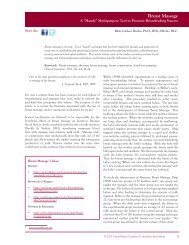Official Journal of the United States Lactation ... - Clinical Lactation
Official Journal of the United States Lactation ... - Clinical Lactation
Official Journal of the United States Lactation ... - Clinical Lactation
You also want an ePaper? Increase the reach of your titles
YUMPU automatically turns print PDFs into web optimized ePapers that Google loves.
Rats are <strong>of</strong>ten used to study how mammalian brains<br />
work, and many effects are similar in human brains. In<br />
studies <strong>of</strong> rats with high- or low-nurturing mo<strong>the</strong>rs, <strong>the</strong>re<br />
is a critical period for turning on genes that control anxiety<br />
for <strong>the</strong> rest <strong>of</strong> life. If in <strong>the</strong> first 10 days <strong>of</strong> life you<br />
have a low-nurturing rat mo<strong>the</strong>r (<strong>the</strong> equivalent <strong>of</strong> <strong>the</strong><br />
first six months <strong>of</strong> life in a human), <strong>the</strong> gene never gets<br />
turned on. The rat is anxious towards new situations for<br />
<strong>the</strong> rest <strong>of</strong> its life, unless drugs are administered to alleviate<br />
<strong>the</strong> anxiety. These researchers say that <strong>the</strong>re are<br />
hundreds <strong>of</strong> genes affected by nurturance. Similar mechanisms<br />
are found in human brains—caregiver behavior<br />
matters for turning genes on and <strong>of</strong>f. (e.g., Meaney,<br />
2001).<br />
We should understand <strong>the</strong> mo<strong>the</strong>r and child as a mutually<br />
responsive dyad. They are a symbiotic unit that<br />
make each o<strong>the</strong>r healthier and happier in mutual<br />
responsiveness. This expands to o<strong>the</strong>r caregivers too.<br />
One strangely popular notion still around today is to<br />
let babies “cry it out” when <strong>the</strong>y are left alone, isolated<br />
in cribs or o<strong>the</strong>r devices. This comes from a misunderstanding<br />
<strong>of</strong> child and brain development.<br />
••<br />
Babies grow from being held. Their bodies get<br />
dysregulated when <strong>the</strong>y are physically separated from<br />
caregivers.<br />
••<br />
Babies indicate a need through gesture and eventually,<br />
if necessary, through crying. Just as adults reach for<br />
liquid when thirsty, children search for what <strong>the</strong>y<br />
need in <strong>the</strong> moment. Just as adults become calm<br />
once <strong>the</strong> need is met, so do babies.<br />
••<br />
There are many long-term effects <strong>of</strong> under care or<br />
need-neglect in babies (e.g., Dawson et al., 2000).<br />
What does “crying it out” actually do to <strong>the</strong> baby and<br />
to <strong>the</strong> dyad<br />
Neurons die. When <strong>the</strong> baby is stressed, <strong>the</strong> toxic hormone<br />
cortisol is released. It’s a neuron killer. A full-term<br />
baby (40 to 42 weeks), with only 25% <strong>of</strong> its brain developed,<br />
is undergoing rapid brain growth. The brain<br />
grows, on average, three times as large by <strong>the</strong> end <strong>of</strong> <strong>the</strong><br />
first year (and head size growth in <strong>the</strong> first year is a sign<br />
<strong>of</strong> intelligence, e.g., Gale et al., 2006). Who knows what<br />
neurons are not being connected or being wiped out<br />
during times <strong>of</strong> extreme stress What deficits might show<br />
up years later from such regular distressful experience<br />
(See my addendum below.)<br />
Disordered stress reactivity can be established as a pattern<br />
for life not only in <strong>the</strong> brain with <strong>the</strong> stress-response<br />
system, but also in <strong>the</strong> body through <strong>the</strong> vagus nerve, a<br />
nerve that affects functioning in multiple systems (e.g.,<br />
digestion). For example, prolonged distress in early life,<br />
resulting in a poorly functioning vagus nerve, is related<br />
to disorders, such as irritable bowel syndrome (Stam et<br />
al, 1997). (See more about how early stress is toxic for<br />
lifelong health from <strong>the</strong> recent Harvard report, The<br />
Foundations <strong>of</strong> Lifelong Health are Built in Early<br />
Childhood).<br />
Self-regulation is undermined. The baby is absolutely<br />
dependent on caregivers for learning how to self-regulate.<br />
Responsive care—-meeting <strong>the</strong> baby’s needs before<br />
he gets distressed—-tunes <strong>the</strong> body and brain up for calmness.<br />
When a baby gets scared, and a parent holds and<br />
comforts him, <strong>the</strong> baby builds expectations for soothing,<br />
which get integrated into <strong>the</strong> ability to self-comfort.<br />
Babies don’t self-comfort in isolation. If <strong>the</strong>y are left to<br />
cry alone, <strong>the</strong>y learn to shut down in face <strong>of</strong> extensive<br />
distress—stop growing, stop feeling, stop trusting (Henry<br />
& Wang, 1998).<br />
Trust is undermined. As Erik Erikson pointed out, <strong>the</strong><br />
first year <strong>of</strong> life is a sensitive period for establishing a<br />
sense <strong>of</strong> trust in <strong>the</strong> world, <strong>the</strong> world <strong>of</strong> caregiver, and<br />
<strong>the</strong> world <strong>of</strong> self. When a baby’s needs are met without<br />
distress, <strong>the</strong> child learns that <strong>the</strong> world is a trustworthy<br />
place, that relationships are supportive, and that <strong>the</strong> self<br />
is a positive entity that can get its needs met. When a<br />
baby’s needs are dismissed or ignored, <strong>the</strong> child develops<br />
a sense <strong>of</strong> mistrust <strong>of</strong> relationships and <strong>the</strong> world. And<br />
self-confidence is undermined. The child may spend a<br />
lifetime trying to fill <strong>the</strong> inner emptiness.<br />
Caregiver sensitivity may be harmed. A caregiver who<br />
learns to ignore baby crying will likely learn to ignore <strong>the</strong><br />
more subtle signaling <strong>of</strong> <strong>the</strong> child’s needs. Secondguessing<br />
intuitions to stop child distress, <strong>the</strong> adult who<br />
ignores baby needs practices and increasingly learns to<br />
“harden <strong>the</strong> heart.” The reciprocity between caregiver<br />
and baby is broken by <strong>the</strong> adult, but cannot be repaired<br />
by <strong>the</strong> young child. The baby is helpless.<br />
Caregiver responsiveness to <strong>the</strong> needs <strong>of</strong> <strong>the</strong> baby is<br />
related to most—if not all—positive child outcomes. In<br />
our work, caregiver responsiveness is related to intelligence,<br />
empathy, lack <strong>of</strong> aggression or depression,<br />
self-regulation, and social competence. Because responsiveness<br />
is so powerful, we have to control for it in our<br />
© 2012 <strong>United</strong> <strong>States</strong> <strong>Lactation</strong> Consultant Association 33




